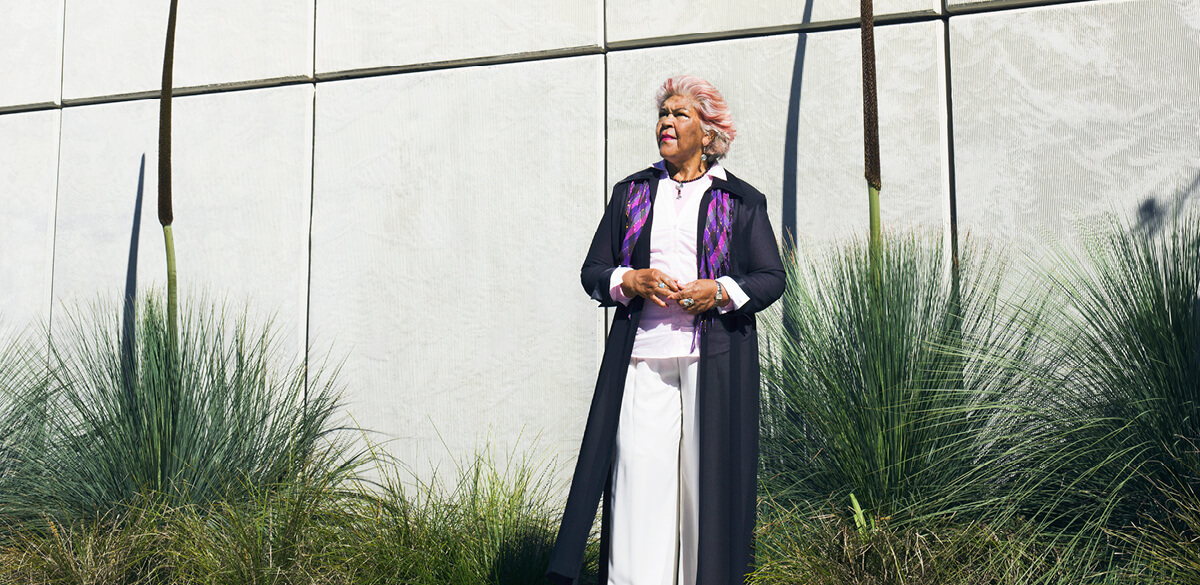
ANCIENT HERITAGE EMBODIED INTO THE BUILT ENVIRONMENT
Seeing Darling Harbour through the eyes of a cultural custodian
Written by Vicky Roach
Photography by Guy Wilkinson
To a casual observer, the glass and concrete skyscrapers that dominate downtown Sydney have pretty much hidden the area’s rich Aboriginal heritage from obvious sight. First Nations Elder Aunty Margret Campbell from Dreamtime SouthernX, however, sees evidence of her ancestors’ footprints everywhere she looks. “Our culture might be hidden from your point of view, but it’s visible to me,” she says, standing in the shade of a Birra Birra (Rusty fig) 100 metres from the entrance of ICC Sydney.
When a First Nations person talks about his or her family tree, they’re not necessarily using it as a figurative expression. Together with their more conventional, biological relatives, First Nations children are part of an extended non-human (animals, fish and reptiles) and botanical family. Birthdays are marked by the plant that was shedding on the day you were born. From that point on, a child inherits a special responsibility for that species’ welfare, which includes the birds and insects that live on it or feed off it.
“There are 15 levels that you learn about from your day of birth, who those family members are,” says Aunty Margret. “That’s the key to our sovereignty.”
Tumbalong Park, which the ICC Sydney Exhibition Centre overlooks, has been replanted in consultation with the traditional custodians of the land, the Gadigal people of the Eora Nation, with many of the native species that grew along the Darling Harbour foreshore more than 60,000 years ago.
A few metres past the fig tree, there’s a clump of Dtharowal (Cabbage-tree palms), from which the area’s original inhabitants would have stripped bark to weave fishing nets (Tumbalong means the “place where seafood is found” in the local Gadigal language).


Now predominantly seen in galleries, the nets’ intricate patterns cleverly mimic the distinctive cross-hatching on the tree trunk. Further along the same path, tussock-grass provides a dense habitat for city lizards. Lavender-flowered lily turf contributes a splash of colour.
Aunty Margret stops to perform a traditional Welcome to Country beside the heritage- listed spiral fountain by Robert Woodward titled Tidal Cascades. She draws attention to its synergy with circular Aboriginal iconography.
Wiping her face with white ochre, the First Nations Elder explains why: “It’s one of 72 primary colours we see in the natural world, so when we are painting our bodies with it, it’s like a policing agent of good manners, (ensuring) that we speak with authenticity and integrity and truth about our relationship with the natural world.”
As the accomplished storyteller gives a broad overview of the First Nations creation story, which is reflected in the heavens, the rainclouds building over Sydney harbour take on a fresh and vital perspective. The threatening downpour feeds naturally into a discussion of traditional borders, which for the Aboriginal people were clearly marked by waterways.
Along with dozens of smaller rivers, creeks and tributaries, the Parramatta, Hawkesbury, Georges and Nepean rivers divided the Eora people into five language groups and 29
clans.
“Water is our dispersal of property,” says Aunty Margret. “If you are ethically and morally tuned into it, you don’t cross it.”
She draws a map in the dirt, making a cross where the men’s ceremonies would have been held, and another for the women’s maternity ward. At this point, she casually mentions that she, herself, has six biological mothers (five of them are her parents’ sisters).
A former educator, Aunty Margret instructs as well as entertains. She draws a vivid impression of the sophisticated cultural systems that would have allowed her ancestors
to travel up and down the waterways, trading, or perhaps arranging a mutually beneficial marriage between clans.
Walking past one of the whales, etched in black vinyl on glass, that welcome visitors to ICC Sydney’s three major buildings — the ICC Sydney Convention Centre, Exhibition Centre and the Aware Super Theatre — Aunty Margret acknowledges the work of renowned First Nations artist Jeffrey Samuels, a founding member of Boomalli Aboriginal Artists Co-operative, who was commissioned by the venue to create a painting that reflected Tumbalong and its waterways.His whales pay homage to the original inhabitants of the area, where a number of ancient rock engravings of the giant marine mammal have been preserved.
At this point Aunty Margret pauses to draw attention to the fact that the inner-city suburb of Redfern, just 3.5 km south of Darling Harbour, and a particular focus for First Nations activism and civil and land rights, is built on a significant deposit of red ochre (one of the sacred colours in First Nations culture). And that beneath the concrete paving stones she’s standing on, there is sandstone and grey shale.

Discover the rich history of ICC Sydney’s surrounding Cockle Bay and Tumbalong Park with Aunty Margret from Dreamtime SouthernX. The uniqueness of Margret’s Aboriginal tourism approach is her living, evidence based, interactive experience where the stories and richness of the Dreamtime landscape interweave with modern living in Sydney. Integral to Margret’s cultural custodianship is her desire to ensure that the world’s oldest continuous, living culture is shared, explored and respected not just with all Australians but beyond Australia.
Seeing Darling Harbour through the eyes of a cultural custodian, one thing becomes crystal clear: it is, was, and always will be Aboriginal land.
